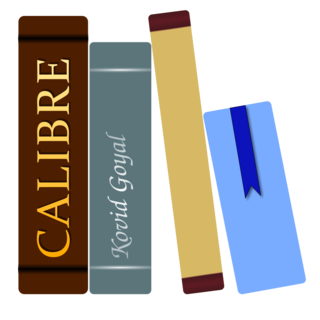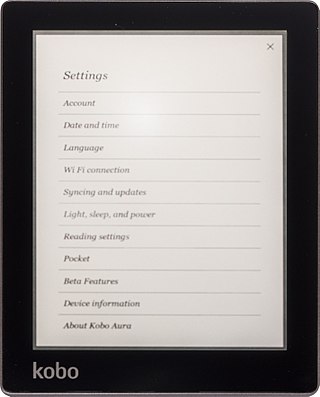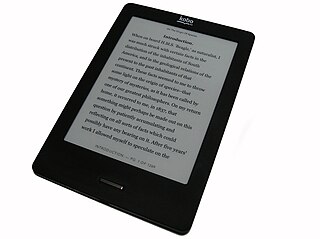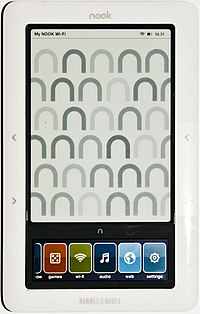An e-reader, also known as an e-book reader, is a portable electronic device that is designed primarily for the purpose of reading e-books and periodicals. E-readers have a similar form factor to a tablet and usually refers to devices that use electronic paper resulting in better screen readability, especially in bright sunlight, and longer battery life when compared to a tablet. An e-reader's battery will typically last for multiple weeks. In contrast to an e-reader, a tablet has a screen capable of higher refresh rates which make them more suitable for interaction such as playing a video game or watching a video clip.

The Sony Reader was a line of e-book readers manufactured by Sony, who produced the first commercial E Ink e-reader with the Sony Librie in 2004. It used an electronic paper display developed by E Ink Corporation, was viewable in direct sunlight, required no power to maintain a static image, and was usable in portrait or landscape orientation.
Mobipocket SA was a French company incorporated in March 2000 that created the .mobi e-book file format and produced the Mobipocket Reader software for mobile phones, personal digital assistants (PDA) and desktop operating systems.

My Life Online (Mylo) was a device created and marketed by Sony for portable instant messaging and other Internet-based communications, browsing Internet web sites using the Opera web browser and playback and sharing of media files. The pocket-sized, tablet-shaped handheld device, which debuted in 2006, had a screen which slid up to reveal a QWERTY keyboard. The brand name 'Mylo' means My Life Online. Using Wi-Fi instead of cellular networks, the Mylo was targeted to the 18–24 age group.

Adobe Digital Editions is an e-book reader software program from Adobe Systems, built initially using Adobe Flash. It is used for acquiring, managing, and reading e-books, digital newspapers, and other digital publications. The software supports EPUB and PDF. It implements a proprietary scheme of digital rights management (DRM) which, since the version 1.5 release in May 2008, allows document sharing among multiple devices and user authentication via an Adobe ID. Digital Editions is a successor to the Acrobat eBook Reader application.
The following is a comparison of e-book formats used to create and publish e-books.
Amazon Kindle is a series of e-readers designed and marketed by Amazon. Amazon Kindle devices enable users to browse, buy, download, and read e-books, newspapers, magazines and other digital media via wireless networking to the Kindle Store. The hardware platform, which Amazon subsidiary Lab126 developed, began as a single device in 2007. Currently, it comprises a range of devices, including e-readers with E Ink electronic paper displays and Kindle applications on all major computing platforms. All Kindle devices integrate with Windows and macOS file systems and Kindle Store content and, as of March 2018, the store had over six million e-books available in the United States.
Fictionwise, owned by Barnes & Noble since 2009, was one of the largest electronic book sellers in North America with an estimated 1.5 million ebook content units sold in 2008. Fictionwise sold both DRM-encrypted and unencrypted (DRM-free) ebooks in various formats that were compatible with computers as well as a wide range of eBook devices, PDAs, and Smartphones.
The eSlick is a discontinued e-book reader, an electronic book (e-book) reading device developed by Foxit Software. It has a 6-inch E Ink screen, 600x800 pixel resolution with 4-level gray scale and a mass of 180 g. The device supports text and PDF format for reading and includes Foxit's PDF Creator and Reader Pro Pack software. In August 2010, Foxit announced that it would stop further development of the eSlick and focus on licensing PDF software to the makers of other e-book hardware. Wired attributed the move to a price war between Amazon.com's Kindle and Barnes & Noble's Nook which undermined Foxit's claim to offer the cheapest e-book reader on the market. Foxit dropped its support completely and abruptly in 2010, completely deleting all references to the eSlick from its site, including numerous forum threads and all firmware updates. This action has alienated and angered many users, as the solutions to many problems were readily available in these threads.

Calibre is a cross-platform free and open-source suite of e-book software. Calibre supports organizing existing e-books into virtual libraries, displaying, editing, creating and converting e-books, as well as syncing e-books with a variety of e-readers. Editing books is supported for EPUB and AZW3 formats. Books in other formats like MOBI must first be converted to those formats, if they are to be edited.

An ebook, also known as an e-book or eBook, is a book publication made available in electronic form, consisting of text, images, or both readable on the flat-panel display of computers or other electronic devices. Although sometimes defined as "an electronic version of a printed book", some e-books exist without a printed equivalent. E-books can be read on dedicated e-reader devices, but also on any computer device that features a controllable viewing screen, including desktop computers, laptops, tablets and smartphones.
The Alex eReader is a discontinued e-book reader created by Spring Design. As with the Barnes & Noble Nook, the Alex features two screens. The upper is a 6-inch monochrome electronic ink screen and the lower is a 3.5 inch HVGA (480×320) touch screen color LCD. The device has Wi-Fi and mobile network connectivity and Internet browsing. The device runs on Android version 1.5. International release was expected during the first week of March 2010. Device shipment began April 14, 2010. Retail sales were discontinued in 2011. The device allows downloading content from web sites such as Google Books, Epub Books, Gutenberg, Web Books, Feed Books, Smash words, and others.

The Kobo eReader is an e-reader produced by Toronto-based Kobo Inc. The company's name is an anagram of "book". The original version was released in May 2010 and was marketed as a minimalist alternative to the more expensive e-book readers available at the time. Like most e-readers, the Kobo uses an electronic ink screen. The Arc tablet series, released between 2011 and 2013, was based on LCD technology instead.

The Nook Color is a tablet computer/e-reader that was marketed by Barnes & Noble. A 7-inch (18 cm) tablet with multitouch touchscreen input, it is the first device in the Nook line to feature a full-color screen. The device is designed for viewing of books, newspapers, magazines, and children's picture books. A limited number of the children's books available for the Nook Color include interactive animations and the option to have a professional voice actor read the story. It was announced on 26 October 2010 and shipped on 16 November 2010. Nook Color became available at the introductory price of US$249. In December 2011, with the release of the Nook Tablet, it lowered to US$169. On 12 August 2012, the price lowered to US$149. On 4 November 2012, the price was further lowered to US$139. The tablet ran on Android.

The Nook Simple Touch is the second generation Nook e-reader developed by Barnes & Noble. It features an 600x800 E Ink screen with a touchscreen that uses a network of infrared beams slightly above the screen surface. The device also has wireless connectivity via Wi-Fi 802.11 b/g/n and a micro USB port for charging and connecting to a computer.

The Kobo Touch is the third generation of the Kobo e-reader device designed by Kobo Inc. It was revealed on 23 May 2011 and was released in the U.S. on 10 June 2011 at a price of $129.99.

The Barnes & Noble Nook is a brand of e-readers developed by American book retailer Barnes & Noble, based on the Android platform. The original device was announced in the U.S. in October 2009, and was released the next month. The original Nook had a six-inch E-paper display and a separate, smaller color touchscreen that serves as the primary input device and was capable of Wi-Fi and AT&T 3G wireless connectivity. The original Nook was followed in November 2010 by a color LCD device called the Nook Color, in June 2011 by the Nook Simple Touch, and in November 2011 and February 2012 by the Nook Tablet. On April 30, 2012, Barnes & Noble entered into a partnership with Microsoft that spun off the Nook and college businesses into a subsidiary. On August 28, 2012, Barnes and Noble announced partnerships with retailers in the UK, which began offering the Nook digital products in October 2012. In December 2014, B&N purchased Microsoft's Nook shares, ending the partnership.

The Nook Tablet is a tablet e-reader/media player that was produced and marketed by Barnes & Noble. It followed the Nook Color and was intended to compete with both e-book readers and tablet computers.

The Kobo Glo is the fourth generation of Kobo eReader devices designed and marketed by Kobo Inc. It was revealed on 6 September 2012 and arrived at retail 14 October 2012 with a price of $129.99 USD/CAD. It is the successor to the popular Kobo Touch was introduced alongside the Kobo Mini and Kobo Arc. The Glo was succeeded in 2015 by the higher-resolution Glo HD, with 4GB built-in storage but no microSD removable storage.

The Nook HD and Nook HD+ are the third generation of Nook's line of color tablet e-reader/media players by Barnes & Noble for using their copy restricted (DRM) proprietary files, or other files. They are the successors to the Nook Tablet and both were released on November 8, 2012.















